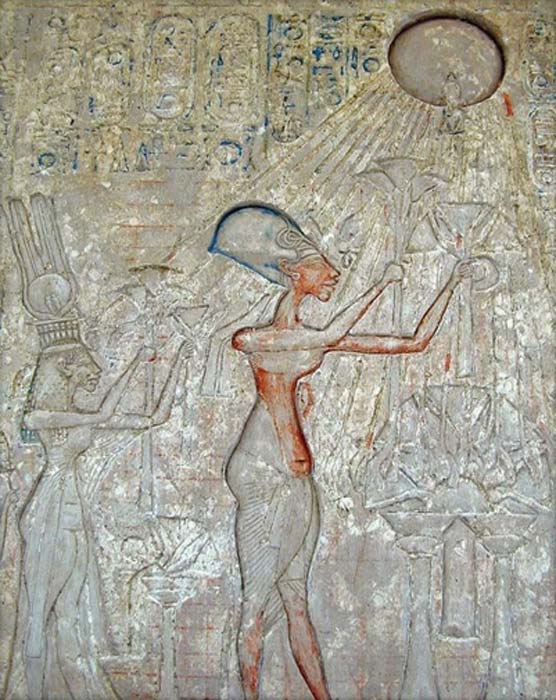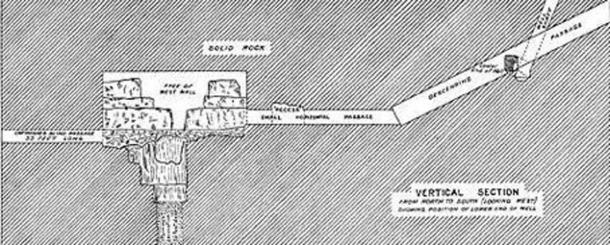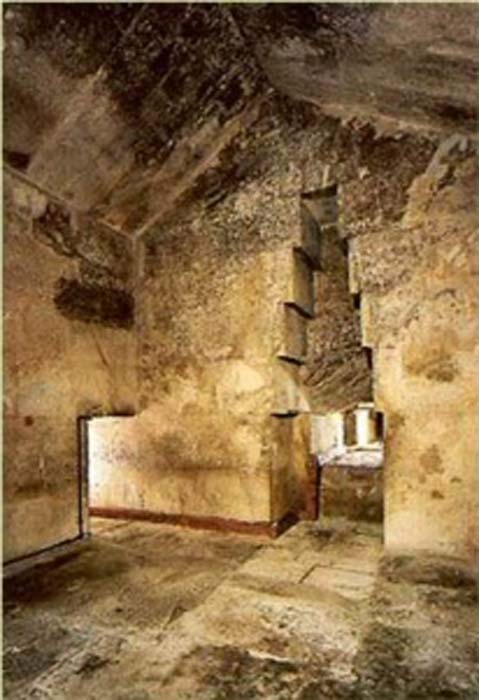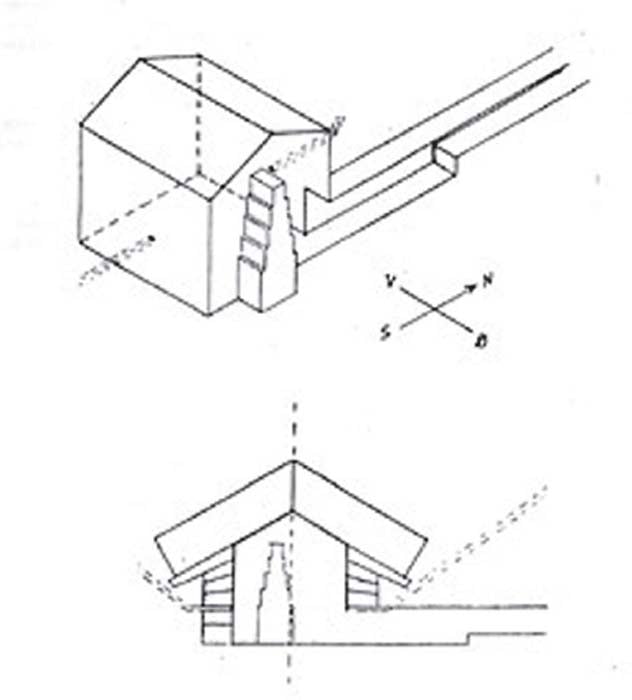
The Great Pyramid: New Theory on God Symbolism and the Hidden Chambers
Architecture is language of form, of three dimensional images reflecting the function of a building and the time it was built. At best it demonstrates the builders’ beliefs regarding life and the world around them. One building never ceases to be an object of discussion: Khufu’s pyramid in Egypt.
Many Egyptologists believe the inside was subject to some rather remarkable plan changes. Of the three known chambers: The Subterranean Chamber, The Queen’s Chamber, and the King’s Chamber, the first two are generally believed to have been abandoned during the building period.
However this article suggests that none of the chambers were abandoned and no change of plans were needed. I must emphasize that I am an architect, not an Egyptologist. My knowledge of ancient Egyptian history is limited. But I do think that understanding of form also matters.
I couldn’t believe that such a colossal building as the Cheops/Khufu pyramid was built in a way that made it subject to plan changes during construction. And suddenly the connection struck! I saw before me a drawing of the pyramid’s chambers and realized that there was a chamber in the ground, one was at the end of a horizontal corridor (in Danish we use a term literally meaning water-level for this) and one had air channels. Could it be as simple as a representation of the four elements?
- The Great Boat of Khufu: The ‘Black Box’ to the Construction of the Pyramids
- Ancient Egyptian Logbook of Inspector Who Helped Construct the Great Pyramid Revealed
The pyramid was built several thousand years prior to the Greek theories of the elements but the major gods of the area at the time of Cheops/Khufu were nature gods: the sun god Ra, the air god Shu, the earth god Geb, among others, and I was back on track…The chambers are all formed exactly as they were intended from the start.
Through the symbolism I deduced from the forms and positions of the known chambers, I believe that it is possible to comprehend the principal ideas of the pyramid’s layout. The chambers fit into a system based on the order of the major gods of the area in the 4th dynasty, around 2500 BC. Furthermore the details of the pyramid reveal that there must be another hitherto unknown chamber higher in the pyramid.

The chambers. (Niels Bjerre Jørgensen)
The place, the priesthood, the gods
Annu is a city some 30 km (18.64 miles) northeast of the great pyramids at Giza. The Bible called it On and the Greeks Heliopolis - city of the Sun. Annu housed a temple and a priesthood which represented the nation’s most influential religion: sun worship.
In Khufu’s time their beliefs and gods were dominant – so these are relevant to the pyramid’s creation. The first five gods of the Heliopolitan creation myth are nature-gods, born in the following sequence:
ATUM who organized the chaotic waters and created the world. At some unknown point in time he merged with the sun god Ra into RA-ATUM
SHU God of Air. The first born child of Atum.
TEFNUT Goddess of Mist and Rain. With Shu she gave birth to the next two:
GEB God of Earth.
NUT Goddess of the starry sky and born last of these gods.

The chambers and elements of the gods. (Niels Bjerre Jørgensen)
Gods and Chambers in the Pyramid
The three known chambers form obvious links to earth, water, and air, (GEB, TEFNUT and SHU) in their locations. GEB’s chamber’s deep in the ground. TEFNUT’s chamber’s at the end of a horizontal, or water level corridor with a sunken floor, and SHU’s chamber has open air shafts.
Examining the architecture closer expands the concept: there must be five chambers in total. The sun god Ra-Atum and Nut, goddess of the starry sky, also had chambers in their honor. Furthermore, it is possible to deduct their approximate locations from the pyramid’s many details.
Did ancient Egyptians have a belief comparable to the Greek theory? The Heliopolitan creation myth operates with gods who were personifications of what resembles the later Greek elements, but the Egyptians had five elements because it included the starry sky in a way resembling the ‘ether’ of the universe, which Plato is credited for inventing.
The creation myth had it (in almost correct order), and the pyramid’s chambers show it. Earth is the heaviest element and thus at the bottom, water upon it, the air above both, and the fire (sun) even higher. Even higher again: the starry sky.
You may object that water wasn’t Tefnut’s element. Her realm was water in the forms of mist and rain. But actually this makes her forms of water more interesting in a vertical ordering of the elements according to weight because rain is water falling from the air and mist is water rising from earth.
Also to be demonstrated in the interior, the Egyptians distinguished between the location of the fire element itself - the sun - high above the air, and the effect here on earth below the air in the form of burning, lighting, warming fire.
In the later Amarna period (18th dynasty), reliefs depict how the sun’s rays hand over the ankh sign of life to king Akhenaten and his family. We can even see how cut-off flowers seem to regain life in the sunlight. This form of fire is represented by the Great Gallery, which is not a proper chamber, but clearly more than a corridor.

Pharaoh Akhenaten (center) and his family worshiping the Aten, with characteristic rays seen emanating from the solar disk. (Public Domain)
GEB’s Chamber – EARTH (The Subterranean Chamber)
The Subterranean chamber measures roughly 8 by 16 meters (26.25 by 52.50 ft.), longest in the east-west direction. In the eastern half a square hole, turned 45 degrees, is dug deep into the bedrock and probably once reached ground water. From the southern wall a small square corridor proceeds a little southwards then ends. In the western half a considerable amount of bedrock is left, giving an unfinished impression.
Many believe that this chamber was originally intended as burial chamber but was abandoned during construction, thus the pile of bedrock. If, however, the chamber follows the order of the elements this is the earth chamber, Geb’s chamber. What better way to demonstrate this than by including bedrock?

Plan of the subterranean chamber. (Public Domain)
A closer look reveals that this actually would have been the burial chamber, if Khufu was buried here at all. It was customary to bury the body in an underground chamber and have an offering chamber above it because it was the earth god Geb who received the body of the deceased. There is even a flat area 2 by 5 meters (6.56 by 16.40 ft.) where it would be possible to assemble a coffin or sarcophagus.
The Greek historian Herodotus visited Egypt c. 500 BC (c. 2000 years after Khufu). He wrote that he was told the king lay buried beneath the pyramid on an island in a water-filled chamber, into which the water came through a brick canal - an astonishingly precise description of how the chamber may have looked.
And if you look at the bedrock left in the chamber it’s an ‘island’ onto which the coffin was placed. The vertical shaft probably acted as a well to obtain water. A frame of wood, eventually tightened by clay, would restrain the water from running back. There even is a ledge it could rest on. With the right amount of water it would look as if the water flooded in from the canal in the southern wall, as demonstrated in the drawing below.
Some believe that Herodotus referred to the existence of another subterranean chamber and others say he was misinformed. But as you can see, it is not necessary to search for another chamber. You just have to place a wooden frame in the well and hoist some water up.
- Surprising Discovery of Metal Hooks in The Solar Boat of Egyptian Pharaoh Khufu
- Ancient Machine Used to Protect Great Pyramid Pharaoh in His Afterlife Revealed

Drawing of the subterranean chamber. (Niels Bjerre Jørgensen)
TEFNUT’s Chamber - WATER (The Queen’s Chamber)
The proper name for the Queen’s chamber would be Tefnut’s chamber. Tefnut’s realm is water as the element between the elements earth and air, which is why her chamber is situated below the air god Shu’s chamber but above the earth god Geb’s chamber.
Danish architect Hubert Paulsen has shown that a hexagon can be inscribed onto the Queen’s chamber. When it is, the center of the hexagon will almost exactly be situated in 1/6 of the pyramid’s original altitude of 280 cubits. The hexagon was a known geometric figure to the ancient Egyptians.
In place of a hexagon, it’s also tempting to inscribe a six-pointed star (something that may not have been known at the time of the pyramid’s construction). This is useful to demonstrate my ideas. The symbol consists of two triangles. One pointing up, and the other pointing down suggesting that magic combines what is above with what is below, like the Tefnut element of water. Maybe they did not use this symbol, but it may also explain the reference to a hexagon in Tefnut’s chamber.

Drawings of the chamber with a hexagon or six-pointed star. (Niels Bjerre Jørgensen)
A little before you enter the chamber the floor drops suddenly one cubit (one cubit measures 52.36 cm/20.61 inches). This is one of the facts that has led many to assume this is another unfinished chamber. But if the ‘missing’ layer of flooring is added to the drawing it doesn’t fit with the hexagon or the star. If instead 21 cm (8.27 inches) of water is added, it fits completely!

The Queen’s or Tefnut’s chamber with the famous niche. (The Pyramids of Tutankhamun)
There is a famous mysterious niche in the eastern wall which some say used to hold a statue. Others hoped it concealed an entrance to a hidden chamber and forced their way through the back wall. Nobody realized that the niche itself is the decoration.
You should look at it as negative space - as if it consists of five boxes on top of each other. This way it tells us there are five elements/gods and five chambers in the pyramid. Almost as a confirmation, the niche is placed so that the side wall of the second “box” aligns with the midline of the chamber, seen from east or west. It is also the pyramid’s midline.

To understand the meaning of the ‘boxes’ it’s necessary to look at the side of the second box, the middle element, which align with the pyramids midline. (Niels Bjerre Jørgensen)
Here in the Queen’s chamber we find another inexplicable construction. The “air shafts” continue high above the chamber and may even have reached the outer surface; but they did not originally open into the chamber. This was done in 1832 by an archaeologist who deduced their existence from the air shafts in the King’s Chamber. The southern shaft, we know now from Gantenbrink’s robot exploration, is blocked high in the pyramid by a stone with remains of copper mounts.
Such copper mounts can hardly have had any other purpose than being for ropes, making the blocking stone a kind of removable cork. If the shafts were permanently closed during the building, they would most likely have used stones without copper mounts. I can imagine several reasons for having the shafts the way they were, but none that fits to theories of an abandoned chamber.
The shafts could be used to demonstrate how water penetrates rock. Their grooves are cut on top of the second layer of stones in the wall and water that was poured down the shafts would probably sieve between the second and third layers and run down the wall to the water on the floor. Or the Gantenbrink cork may have hindered the shaft from being filled with sand.
SHU’s Chamber – AIR (The King’s Chamber)
In this, the highest position of the known chambers, we find open air shafts. It must be SHU’s chamber. In the Book of the Dead, written on the wall of a later king’s pyramid (Pepi II from 6th dynasty), we find:
“O Great Company of the gods who dwell in Annu (Heliopolis), grant that Pepi Nefer-ka- Ra may flourish (literally ‘germinate’), and that his pyramid, his everlasting building, may flourish, even as the name of Temu [ATUM] , the chief of the nine gods, doth flourish.
If the name of Shu, the lord of the upper shrine in Annu, flourisheth, then Pepi shall flourish, and his pyramid, his everlasting building, shall flourish!
If the name of Tefnut, the lady of the lower shrine in Annu, flourisheth, the name of Pepi shall be established, and this his pyramid shall be established to all eternity!
If the name of Seb [GEB] flourisheth at the “homage of the earth”, then the name of Pepi shall flourish, and this his pyramid shall flourish, and this his building shall flourish unto all eternity!
If the name of Nut in the House of Shenth in Annu flourisheth, the name of Pepi shall flourish, and this his pyramid shall flourish, and this his building shall flourish unto all eternity!”
This almost contemporary sequence from the Old Kingdom seems to indicate that in Annu shrines for Shu and Tefnut were placed as ‘upper’ and ‘lower’ shrines. Maybe the sequence actually speaks of the Great pyramid and its chambers.
In a country stretching from Nubia to the Mediterranean Sea, it was a minor deviation to describe Khufu’s pyramid as if it actually lay in Annu, or just outside. As the theory of this article points out, the gods of Annu may also have been so closely connected with the pyramid, being a temple honoring them, that they were practically identified with each other. Mentioning Geb’s chamber as “the homage of the earth” is wonderfully poetic, when you remember the way it was staged.
To enter Shu’s chamber you have to pass through The Grand Gallery and the Ante chamber. First, we concentrate on the so-called “construction chambers” directly above the chamber. The generally accepted theory of why these strange layers of stones and in-between spaces were made claims they were made to reduce pressure on the chamber’s ceiling.

The King’s chamber with antechamber and “construction chambers” above it. From J. & M. Edgar: ‘The Great Pyramid Passages and Chambers.’ (Author provided)
But why not increase the space between the layers, if reducing weight was the issue? This is another “Well we cannot think of a better reason” - theory that should never have been accepted. The Queen’s chamber was built first, has no such weight relieving chambers, but still stands in spite of a much bigger pressure, being lower in the pyramid.
We are so accustomed to building for practical purposes that we often forget to consider other reasons. If we assume a symbolic meaning with these small chambers in honor of Shu they suddenly become a logical addition to Shu’s chamber.
- Unraveling the Mystery of the Great Pyramid Air-Shafts
- A Forgotten Sphinx and Faked Cartouche: Changing the Course of Ancient Egyptian History?
There are five cavities, one for each god/element/chamber in the pyramid. Note that these small chambers are defined by having their ceilings made into flat levels. Emphasis on ceiling means linking the chamber in question to the lighter elements, or the gods themselves. Which is why these small chambers quite certainly are symbolic and meant to honor the gods.
The upper cavity has a pointed ceiling seen from east or west. The highest real chamber in the pyramid, belonging to Nut, was probably situated in the pyramid’s peak. Its walls - or its ceiling, if you like - consisted solely of the pyramid’s casing stones, maybe supported by a wooden structure. When an earthquake made the casing stones slide off, Nut’s chamber disappeared.
The three lower cavities have granite sides seen from east or west as well as granite floors and ceilings. So have the three known real chambers. It seems reasonable to connect these three lower cavities to the known chambers. Symbolically the hard granite may represent the physical world - the three elements we live in - earth, water, and air.
This theory of the possible construction method of the Khufu Pyramid is continued in the second part of this article here.
Top Image: The Pyramid of Cheops illuminated by the sun in backlight, with people entering inside to visit it. The area with the great pyramids of Giza, Egypt. Source: Alfredo /Adobe Stock















Comments
In "Sacred Science; The King of Pharaonic Tradition" by R. A. Schwaller De Lubicz, the four elements of the Greeks are integrated with ancient Egyptian symbolism and pertaining to the construction materials of the Great Pyramid there is more symbolism:
"Granite, coming from fire, is also employed for certain doors or for colossi. At Luxor, for example, the colossi standing or walking in the name of Ramses (birth of the Sun) which surround the first court of the temple are of red granite" (p. 95).
The prevailing beliefs of Heliopolis dictate that the god Ra-Atum is supreme and so the ritual chambers of the other oldest of gods are linked by the element of fire, because of their construction with red granite. The white limestone that once covered the pyramid, reflecting the sun's rays, is symbolized as air (p. 102), which surrounds the structure (like the primordial element, hydrogen, which ultimately formed into stars).
The above article mentioned Pharaoh Akhenaton who was privy to this ancient belief system, appropriating the titles for himself and his queen as the gods Shu and Tefnut:
"The original triad consisting of Atum, the primeval father, his son Shu, and daughter Tefnut is now replaced by a triad consisting of the Aten as the father and the living king and queen as his children. The unique iconography of both royals as displayed in statuary and reliefs reflects this new interpretation of their divine status" (The Oxford History of Ancient Egypt, by Ian Shaw, p. 276).